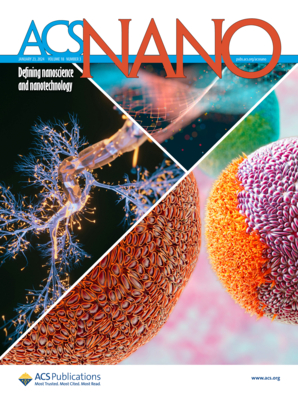原位聚合杂化纳米纤维膜提高固态锂金属电池的高压稳定性。
IF 16
1区 材料科学
Q1 CHEMISTRY, MULTIDISCIPLINARY
引用次数: 0
摘要
固态锂金属电池,特别是那些具有固体聚合物电解质的电池,被认为是实现更高能量密度和安全性的有前途的解决方案。然而,它们的发展一直受到有限的高压容限的阻碍。为了克服这一挑战,我们提出将一种多功能杂化纳米纤维膜与碳酸乙烯原位聚合相结合,以创造一种具有优异高压稳定性和高效室温性能的固体电解质。极性基团与碳酸乙烯之间的偶极-偶极相互作用提高了相容性和离子电导率。我们的方法提供了具有惊人循环稳定性的LiFePO4//Li电池,在1C下超过1000次循环,特别是与高压Li3V2(PO4)3 (4.8 V vs Li/Li+)和LiNi0.8Co0.1Mn0.1O2 (4.7 V vs Li/Li+)具有出色的兼容性。这种简单而有效的策略有助于更安全、更高能量密度的固态锂金属电池的能量存储。本文章由计算机程序翻译,如有差异,请以英文原文为准。
In Situ Polymerized Hybrid Nanofiber Membranes Boost High-Voltage Stability of Solid-State Lithium Metal Batteries.
Solid-state lithium metal batteries, particularly those with solid polymer electrolytes, are regarded as promising solutions to achieve both higher energy density and safety. However, their development has been hampered by limited high-voltage tolerance. To overcome this challenge, we propose integrating a multifunctional hybrid nanofiber membrane with in situ polymerization of vinylene carbonate to create a solid electrolyte with exceptional high-voltage stability and efficient room-temperature performance. The improved compatibility and ionic conductivity arise from dipole-dipole interactions between polar groups and vinylene carbonate. Our approach delivers LiFePO4//Li cells with marvelous cycling stability, surpassing 1000 cycles at 1C, and especially shows excellent compatibility with high-voltage Li3V2(PO4)3 (4.8 V vs Li/Li+) and LiNi0.8Co0.1Mn0.1O2 (4.7 V vs Li/Li+). This straightforward yet effective strategy contributes to energy storage with safer and higher-energy-density solid-state lithium metal batteries.
求助全文
通过发布文献求助,成功后即可免费获取论文全文。
去求助
来源期刊

ACS Nano
工程技术-材料科学:综合
CiteScore
26.00
自引率
4.10%
发文量
1627
审稿时长
1.7 months
期刊介绍:
ACS Nano, published monthly, serves as an international forum for comprehensive articles on nanoscience and nanotechnology research at the intersections of chemistry, biology, materials science, physics, and engineering. The journal fosters communication among scientists in these communities, facilitating collaboration, new research opportunities, and advancements through discoveries. ACS Nano covers synthesis, assembly, characterization, theory, and simulation of nanostructures, nanobiotechnology, nanofabrication, methods and tools for nanoscience and nanotechnology, and self- and directed-assembly. Alongside original research articles, it offers thorough reviews, perspectives on cutting-edge research, and discussions envisioning the future of nanoscience and nanotechnology.
 求助内容:
求助内容: 应助结果提醒方式:
应助结果提醒方式:


